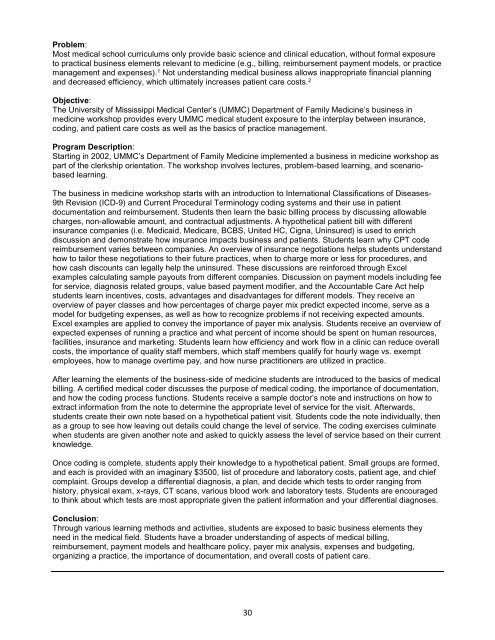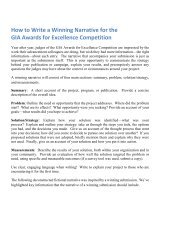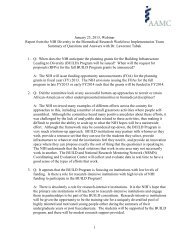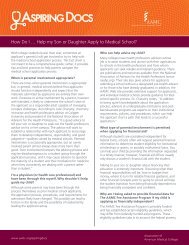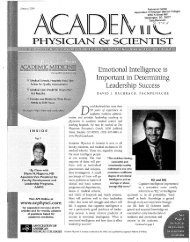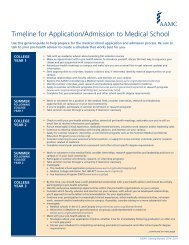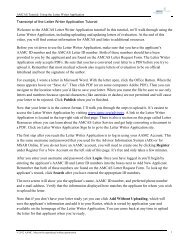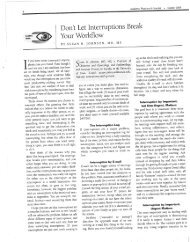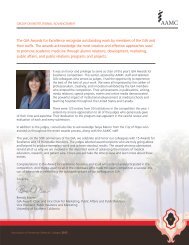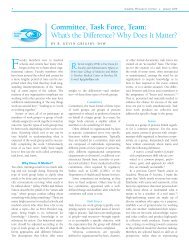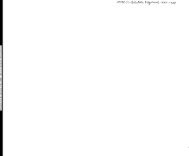2013 Poster Session Summaries - AAMC
2013 Poster Session Summaries - AAMC
2013 Poster Session Summaries - AAMC
You also want an ePaper? Increase the reach of your titles
YUMPU automatically turns print PDFs into web optimized ePapers that Google loves.
Problem:<br />
Most medical school curriculums only provide basic science and clinical education, without formal exposure<br />
to practical business elements relevant to medicine (e.g., billing, reimbursement payment models, or practice<br />
management and expenses). 1 Not understanding medical business allows inappropriate financial planning<br />
and decreased efficiency, which ultimately increases patient care costs. 2<br />
Objective:<br />
The University of Mississippi Medical Center’s (UMMC) Department of Family Medicine’s business in<br />
medicine workshop provides every UMMC medical student exposure to the interplay between insurance,<br />
coding, and patient care costs as well as the basics of practice management.<br />
Program Description:<br />
Starting in 2002, UMMC’s Department of Family Medicine implemented a business in medicine workshop as<br />
part of the clerkship orientation. The workshop involves lectures, problem-based learning, and scenariobased<br />
learning.<br />
The business in medicine workshop starts with an introduction to International Classifications of Diseases-<br />
9th Revision (ICD-9) and Current Procedural Terminology coding systems and their use in patient<br />
documentation and reimbursement. Students then learn the basic billing process by discussing allowable<br />
charges, non-allowable amount, and contractual adjustments. A hypothetical patient bill with different<br />
insurance companies (i.e. Medicaid, Medicare, BCBS, United HC, Cigna, Uninsured) is used to enrich<br />
discussion and demonstrate how insurance impacts business and patients. Students learn why CPT code<br />
reimbursement varies between companies. An overview of insurance negotiations helps students understand<br />
how to tailor these negotiations to their future practices, when to charge more or less for procedures, and<br />
how cash discounts can legally help the uninsured. These discussions are reinforced through Excel<br />
examples calculating sample payouts from different companies. Discussion on payment models including fee<br />
for service, diagnosis related groups, value based payment modifier, and the Accountable Care Act help<br />
students learn incentives, costs, advantages and disadvantages for different models. They receive an<br />
overview of payer classes and how percentages of charge payer mix predict expected income, serve as a<br />
model for budgeting expenses, as well as how to recognize problems if not receiving expected amounts.<br />
Excel examples are applied to convey the importance of payer mix analysis. Students receive an overview of<br />
expected expenses of running a practice and what percent of income should be spent on human resources,<br />
facilities, insurance and marketing. Students learn how efficiency and work flow in a clinic can reduce overall<br />
costs, the importance of quality staff members, which staff members qualify for hourly wage vs. exempt<br />
employees, how to manage overtime pay, and how nurse practitioners are utilized in practice.<br />
After learning the elements of the business-side of medicine students are introduced to the basics of medical<br />
billing. A certified medical coder discusses the purpose of medical coding, the importance of documentation,<br />
and how the coding process functions. Students receive a sample doctor’s note and instructions on how to<br />
extract information from the note to determine the appropriate level of service for the visit. Afterwards,<br />
students create their own note based on a hypothetical patient visit. Students code the note individually, then<br />
as a group to see how leaving out details could change the level of service. The coding exercises culminate<br />
when students are given another note and asked to quickly assess the level of service based on their current<br />
knowledge.<br />
Once coding is complete, students apply their knowledge to a hypothetical patient. Small groups are formed,<br />
and each is provided with an imaginary $3500, list of procedure and laboratory costs, patient age, and chief<br />
complaint. Groups develop a differential diagnosis, a plan, and decide which tests to order ranging from<br />
history, physical exam, x-rays, CT scans, various blood work and laboratory tests. Students are encouraged<br />
to think about which tests are most appropriate given the patient information and your differential diagnoses.<br />
Conclusion:<br />
Through various learning methods and activities, students are exposed to basic business elements they<br />
need in the medical field. Students have a broader understanding of aspects of medical billing,<br />
reimbursement, payment models and healthcare policy, payer mix analysis, expenses and budgeting,<br />
organizing a practice, the importance of documentation, and overall costs of patient care.<br />
30


